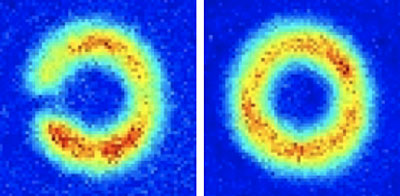The electric circuit is "non-trivial" since it includes a circular element - an adapted barrier that controls the flux of the current of atoms for defined permissible values

Researchers from the National Institute of Standards and Technology and the University of Maryland succeeded in making the first "atomic circuit" of its kind, a donut-like loop of supercooled gas atoms moving in a rotary current in a manner analogous to a ring of electrons moving inside a superconducting wire. The electric circuit is "non-trivial" since it includes a circular element - an adjusted barrier that controls the flow of the current of atoms for specified permissible values.
Supercooled gases, such as Bose-Einstein condensation (The entry in Wikipedia) of sodium atoms for this experiment, are liquids that obey the extraordinary laws of the quantum world. Atomic quantum liquids have the potential to develop highly accurate versions of sensors and other electronic devices such as gyroscopes (an auxiliary device for maintaining stability in navigation facilities). Electric circuits of supercooled helium are already used today for rotation detection.
Superconducting quantum interference devices (SQUIDs) use superconducting electrons in a loop to make sensitive measurements of magnetic fields. Many scientists aim to develop a super-cooled gas version of these devices, which would be able to detect rotation. Combined with other supercooled atomic gas electronic devices and parallel electrical circuits, or "atomtronics" that the researchers envision, such as diodes and transistors, this research could form the basis of a new generation of highly accurate supercooled gas-based sensors. more
In order to produce their atomic electric circuit, the researchers created a constant and stable current - a frictionless flow of particles - from the Bose-Einstein condensation of sodium atoms held by an arrangement of lasers in a structure known as an optical trap that bounds them into an annular, doughnut-like shape. Persistent flow – lasting for a record-breaking 40 seconds in this experiment – is the hallmark of superfluidity, the liquid equivalent of superconductivity.
The stream of atoms does not travel along the ring at any speed, but only at definite and discrete values, which in this experiment correspond to a single quantum of angular momentum. A focused laser beam produces the circular element - a barrier along one side of the ring. The barrier consists of a "weak link" capable of turning off the current around the loop.
The superflow stops abruptly when the barrier strength is high enough. Similar to water in a garden hose, the atoms gain speed near the barrier. However, when the speed approaches a critical value, the atoms suddenly encounter resistance to their flow (viscosity) and the cyclic flow stops, since there are no longer any external forces supporting it.
In the Bose-Einstein condensation, researchers previously succeeded in creating Josephson junctions - a tiny barrier separating two superfluid regions, in a single atomic trap. Quantum entanglement superconducting devices require the presence of a Josephson junction in the circuit.
This study demonstrates the practical application of a complete atomic electric circuit, containing a superfluid current ring and a tunable weak bond barrier. This research, therefore, constitutes an important step forward towards the development of parallel atomic quantum interference superconducting devices.

2 תגובות
I agree with Adi.
It feels like Google Translate. Can't understand anything
As usual, the news in Hebrew cannot be read. Already in the second sentence the meaning of what is written in the original news is completely distorted.
There is a reason why under most of Dr. Moshe Nachmani's interesting articles there are no comments at all. Luckily there is always a link to the original article.